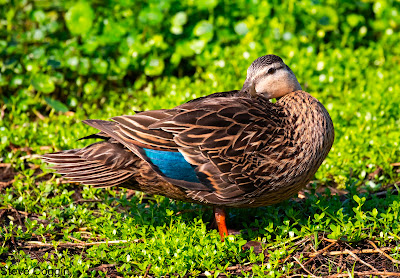 |
| Male Mallard (Anas platyrhynchos). Rowan County, North Carolina. |
Mallards (Anas platyrhynchos) are the ducks that people think of when they think of ducks. Mallards are large ducks with a wingspan of about 3 feet and weigh about 3 pounds. Males have an iridescent green head, a white collar and maroon breast. Females have a more muted color pattern of mottled brown with an eye stripe. Males Mallards have a yellow beak with a black tip and females have a brown beak. Both male and female Mallards have a bright patch of iridescent blue feathers on the wing called a speculum. The speculum has white borders and is visible when the ducks are in flight but is harder to see when they are not airborne. Mallards also have white on their tail feathers.
 |
| Female and male Mallards. Buncombe County, North Carolina. |
 |
| Male and female Mallards feeding. Buncombe County, North Carolina. |
Rowan County, North Carolina.
While male Mallards are unmistakable, females Mallards look very similar to other species of ducks, in the genus Anas, including the males. American Black Ducks (Anas rubripes), Mottled Ducks (Anas fulvigula) and Mexican Ducks (Anas diazi) all strongly resemble female Mallards.
 |
| American Black Duck (Anas rubripes) in flight. This duck's dark body, lighter head and violet speculum are all visible. Alligator River, National Wildlife Refuge, Dare County, North Carolina. |
 |
| American Black Duck in flight showing white undersides of wings. Alligator River National Wildlife Refuge, Dare County, North Carolina. |
American Black Ducks are widespread in eastern North America. They breed from northern Canada and the upper Midwest and down to North Carolina. The northern-most America Black Ducks migrate in winter and can be found as far south as the gulf coast from Louisiana to north Florida. America Black Ducks look like very dark female Mallards. Their heads are lighter than the body, the undersides of the wings are white, and the speculum is violet. American Black Ducks are the largest ducks in the genus Anas and readily produce fertile hybrids with Mallards.
 |
| Female and male Mottled Ducks (Anas fulvigula). West Delray Regional Park, Palm Beach County, Florida. |
 |
| Mottled Duck showing iridescent blue speculum. Green Cay Wetlands, Palm Beach County, Florida. |
 |
| Mottled Duck. Green Cay Wetlands, Palm Beach County, North Carolina. |
 |
| Mexican Duck (Anas diazi) displaying its blue speculum. Willcox Playa, Cochise County, Arizona. |
 |
| Female and male Mallards. Rowan County, North Carolina. |
Why do all these ducks look like female Mallards? All four of these species are closely related. The evolutionary ancestor of this whole group probably looked like the female Mallards of today. Genetic studies tell us Mottled Ducks diverged from Mallards about 390,000 years ago, Mexican Ducks became a distinct species about 325,000 years ago, and Black Ducks and Mallards separated only 180,000 years ago. While these are long stretches of time, they are but an instant in evolutionary history. These ducks are all still in the process of becoming genetically isolated from each other.
 |
| Male Mallard Rowan County, North Carolina. |
Another question is why the males and females of Mottled
Ducks, Black Ducks and Mexican Ducks look similar, but in Mallards the males
and females look dramatically different.
For some reason, in the Mallard line, the females favored flashily
colored males. Over time a process
called sexual selection produced the extravagant males we see today. Why this has not happened in other ducks of the Mallard continuum is a mystery.
No comments:
Post a Comment